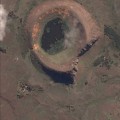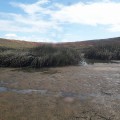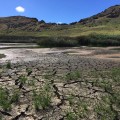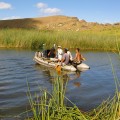Rapa Nui Eco-Crisis?
Dear EISP Friends,
Our attention is still fixed firmly on the preparation of our Atlas manuscript. We have engaged with colleagues, exchanged data with collaborators, and traced down myriads of new ideas, all of which were stimulating and enlightening scholarly adventures. In May we traveled to Rapa Nui with Jeff Brown and the amazing crew of the PBS NewsHour “Cultures At Risk”! We met new friends in the Rapanui community who are devoted to conservation in the face of new climate change threats.
Rano Raraku Lake Water Depletion
During our excavation program we collaborated with geologist R. Dunn (2013). He mapped the inner basin of Rano Raraku and cored a portion of the slope. We also assisted S. Wachsmann and J. Morris of Texas A&M University’s Nautical Archaeology Program and the Institute of Nautical Archaeology (INA) to conduct a sub-bottom profiler survey of the Rano Raraku lake (Wachsmann and Morris, 2012). Rano Raraku is an important fresh water source on an island where drought is a major concern. So, when the Rano Raraku lake level recently appeared to fall dramatically, we turned to these colleagues. Read their reports here:
- Basic Geology of Rano Raraku, Easter Island (with focus on groundwater), Richard K. Dunn, Ph.D.
- The 2012 INA/EISP Rano Raraku Crater Lake Survey, Shelley Wachsmann & Jeff Morris
- Rano Raraku lake map, INA/EISP Rano Raraku Crater Lake Survey, Morris and Wachsmann, March 2012
Dunn pointed out that Rano Raraku stone (tuff) contains abundant fractures that act as conduits for groundwater. Precipitation enters these fractures and groundwater flow delivers water to the lake. It sits 30-40 m above the surrounding land surface and approximately 65 m above the regional groundwater table. The lake level has fluctuated in the past, and Juan Tepano told Katherine Routledge that, when he was a young boy, the lake was just a marsh. In general, seepage out of the lake has balanced the in-flow of precipitation-derived water.
In July 2017, the lake level appeared to be normal (Figure 1), but by September there was a noticeable decrease. On January 25, 2018 the surface of the water displayed an unusual pattern (Figure 2). The reason for the rapid reduction in lake level that subsequently took place (Figure 3) is unknown, but one possibility is increased lake drainage through bedrock fractures. By our May visit the water level was up again. Chilean scientific consultants opined that the cause of the original water loss was low precipitation and evaporation (Figure 4).
According to Dunn, a possible aggravating cause is regional seismic activity. We are all aware of the restless volcanic activity of Mauna Kea in Hawai’i. It is also noteworthy that seismic activity is recorded on the East Pacific Rise, 350 km west of Rano Raraku, as recently as February 27, 2018 (Mag 4.7, 10 km depth; USGS). The result of this situation for Rapa Nui is a renewed awareness of the potential threats of climate change. In November an international scientific conference will discuss the pressing issues facing the island today, one of which may be variable rainfall and drought.
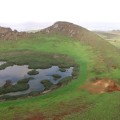
Figure 4. Rano Raraku lake as seen during filming of PBS NewsHour, May 2018. Still from video by Malcom Brown, PBS NewsHour.
 English
English  Español
Español 